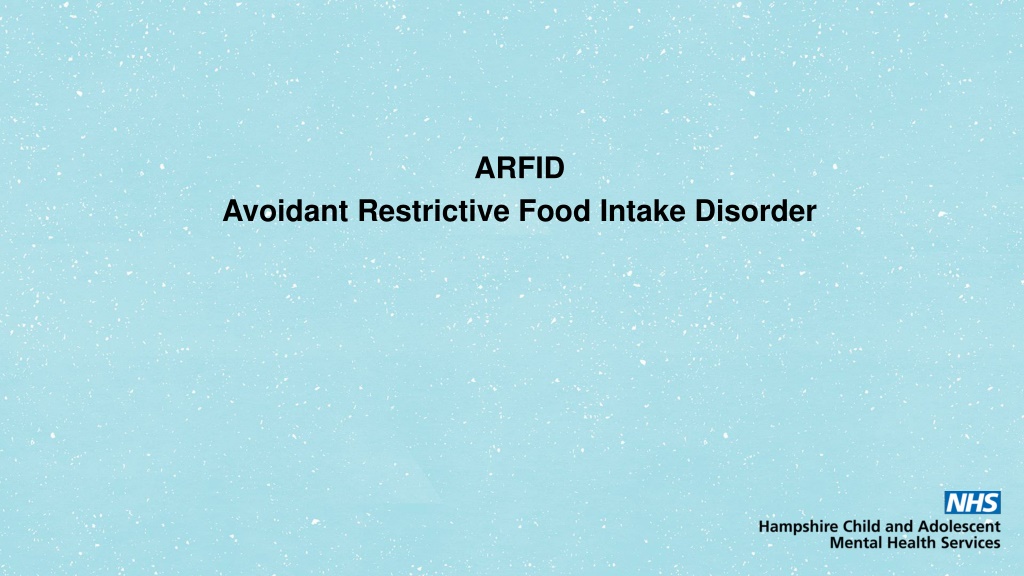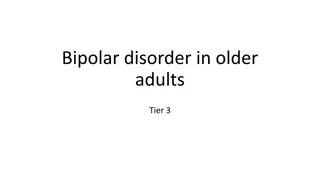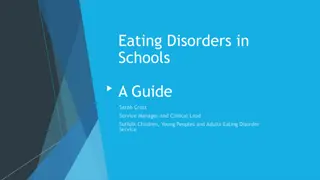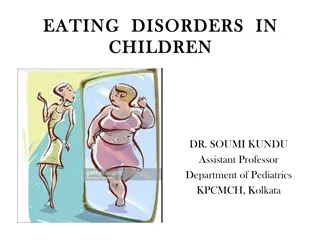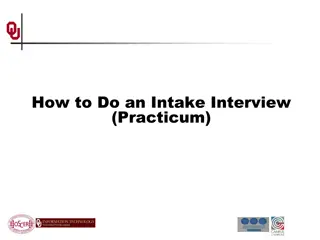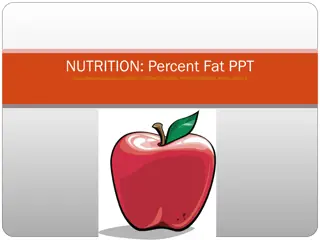Understanding ARFID: A Guide to Avoidant Restrictive Food Intake Disorder
Avoidant Restrictive Food Intake Disorder (ARFID) is a feeding and eating disorder characterized by significant weight loss, nutritional deficiency, and psychosocial impairment. Individuals may experience sensory sensitivity, lack of interest, or fear of aversive consequences. ARFID differs from picky eating as it is pervasive and chronic, impacting health and daily functioning. Signs include limited food selection, refusal to eat, and anxiety over new foods. Causes may involve early feeding difficulties, medical issues, or maternal anxiety. Early intervention is key for better outcomes.
Download Presentation

Please find below an Image/Link to download the presentation.
The content on the website is provided AS IS for your information and personal use only. It may not be sold, licensed, or shared on other websites without obtaining consent from the author. Download presentation by click this link. If you encounter any issues during the download, it is possible that the publisher has removed the file from their server.
E N D
Presentation Transcript
ARFID Avoidant Restrictive Food Intake Disorder
What is ARFID? Avoidant Restrictive Food Intake Disorder is a feeding and eating disorder. Diagnostic eligibility; - Significant weight loss/ faltering growth/ development - Significant nutritional deficiency - Dependence on enteral feeding or oral supplements - Marked inference with psychosocial functional
There are three main types of difficulties that people with ARFID can experience. Some experience one, two or all three of these difficulties: 1) Sensory Sensitivity 2) Lack of Interest 3) Fear of Aversive Consequences Young people with Autistic Spectrum Condition can have also have diagnosis of ARFID.
How is ARFID different to fussy or picky eating? Strong preferences and dislikes = normal and appropriate Children eat more/ less in response to feeling upset, worried, angry or overwhelmed ARFID = pervasive and chronic difficulties causing a significant impact on their health, development and functioning in every day life.
Signs and symptoms: What might it look like from your perspective? May be underweight, average weight or overweight Will eat an extremely limited selection of foods (e.g., only certain brands) or stop eating altogether Impact on family functioning and dynamics Young people with ARFID can present very young Rarely appearing to be hungry or asking for food Avoiding or refusing to sit down for feeding or needing distraction to eat Gagging or vomiting when attempting to eat High anxiety over new foods
Causes and Risk Factors There is often not a single cause. Risk factors; Premature birth and complex medical issues in early life Early feeding difficulties- latching on (breastfeeding) Vomiting or gastric reflux as an infant Severe constipation Eczema/Food allergies Late introduction of solid foods Developmental difficulties/ delay General dislike of change or anything new Maternal/systemic anxiety and enmeshment
What to do if concerned a young person may have ARFID Early intervention = better outcomes Watch and Wait is not recommended - - - - Have the conversation with the young person and their primary care giver Seek consent to share information with relevant people (e.g., GP, CAMHS) Seek consultation and advice from ED service providers Be mindful of safeguarding concerns- seek consultation
ARFID assessment Meeting with a health care professional who has specialist knowledge of ARFID Completing several questionnaires which will provide insight into- child developmental/medical history, behaviours towards foods sensory needs/ communication skills Physical health review which will include weight and height and a baseline blood profile to ensure there are no deficiencies (if there is anxiety related to blood taking there is a specialist resource to accommodate this issue!) It is important the child attends the appointment and their perspective and experience is heard!
General tips - - Feeding difficulties are usually long standing and are difficult to change Avoid: force feeding having long gaps between meals to try to evoke hunger withholding preferred/safe foods using reward systems Allow exceptions for children to eat safe foods at school Be mindful of contamination fears and not enforcing this for those with ARFID Don t overly worry about healthy eating - - -
Practical approaches and techniques for supporting a young person with ARFID Tips for managing sensory sensitivity During the meal, aim to reduce sensory stimuli by: - Familiar and predictable meal time routine - Allow the child to eat on their own, especially if they seem anxious/overwhelmed - Reduce background noise - Avoid bright lighting - Create a comfortable and supportive place to sit at mealtimes - Ensure the dining table is free of clutter - Have one food on the plate at a time - Have something heavy on their lap
Tips for managing sensory sensitivity - - Introduce new smells and foods gradually Avoid stressful periods when making changes or introducing foods e.g. Christmas, start of new school term If anxious/overwhelmed at meal times use gentle distraction (avoid anything that is likely to be stimulating) -
Practical approaches and techniques for supporting a young person with ARFID Tips for managing lack of interest - - - - - Routine: offer food and fluid regularly Use external reminders Consider the division of responsibility Fun and social Role modelling
Tips for managing fear of aversive consequences - - - Role modelling Regular exposure to safe and new foods Positive feedback and praise
Things to remember: Feeding difficulties are usually long standing and change/ progress may be SLOW and LIMITED but changes are possible with: Clear expectations and boundaries Consistency in approach; structure and routine Perseverance/ commitment Motivation to make changes
Boundaries and Role Modelling - Set family rules around eating behaviour e.g., we all have breakfast. This might mean the family system has to make adjustments to support the changes we need for the young person with ARFID - It can be helpful to approach food as medicine; we don t have to love/ enjoy the food we eat but we do have to tolerate it for our wellbeing and functioning. - Depending on risk of physical health compromise, you may need to reduce or limit activities if nutrition is inadequate e.g., you cannot take driving lessons unless you are eating regularly as it may not be safe for you or other drivers if you have not eaten and you get behind the wheel of a car - Role Modelling trying new things, stepping outside of your comfort zone and embracing change in a positive manner can be helpful.
Consistency, Perseverance and Commitment - If changes are desired and needed then changes in mindset, attitude and behaviour are required from all family members not just the young person with ARFID. - Consistency of approach and messages between caregivers is crucial (e.g., in respect to boundaries, expectations, rules etc). - Parenting a child with ARFID can be exhausting. It s easy to fall into a habit of only offering preferred foods. It takes perseverance and commitment by the young person and their care givers to persist in making changes and doing something different e.g., need to try several times a day, every day for a prolonged period of time- trying things once a week will not result in change. - Change is scary, uncomfortable and not enjoyable. Young people may lose sight of why change is necessary or important so adult caregivers need to remain positive, hopeful and encouraging.
Goal Setting and Motivation - Everyone needs a reason to do or not do something. Goals and motivational reasons will differ between young people and their parents. E.g., parents motivated by frustration at finding acceptable foods, exhaustion and worry for child s health and wellbeing, wanting them to do well at school, not limit their opportunities etc. whereas young people may not share these worries and therefore these are not motivating factors for them to work towards change. - Push factors: things that help move us away from a position e.g., my hair is falling out because nutritionally I m compromised. I don t want my hair to fall out so I have motivation to make changes to stop this from happening - Pull factors: things that help us move towards a position e.g., I want a boy/girl friend and want to be able to go out for dinner. I cant currently do that so I am motivated to make changes so I can go to a restaurant with my partner. - There is a timing element with change work. A young person has to have internal, personal reasons to make changes for them to engage in the process fully and for sustained and significant progress to be made
Resources Hampshire CAMHS website; www.hampshirecamhs.nhs.uk Beat Website; https://www.beateatingdisorders.org.uk/types/arfid Child Feeding Guide; https://www.childfeedingguide.co.uk/ Food Refusal and Avoidant Eating in Children; A practical guide for parents and professionals by Gillian Harris and Elizabeth Shea Avoidant Restrictive Food Intake Disorder- A guide for parents and carers by Rachel Bryant-Waugh Helping Children Develop A Positive Relationship With Food by Jo Cormack
